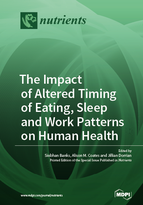The Impact of Altered Timing of Eating, Sleep and Work Patterns on Human Health
A special issue of Nutrients (ISSN 2072-6643).
Deadline for manuscript submissions: closed (30 November 2016) | Viewed by 134234
Special Issue Editors
Interests: meal timing health; circadian rhythms and metabolic function; cognitive performance
Interests: meal timing; eating patterns; circadian rhythm; shift work; cardiovascular risk factors
Special Issues, Collections and Topics in MDPI journals
Interests: sleep; chronobiology, shiftwork, sleep in pregnancy, biostatistics
Special Issues, Collections and Topics in MDPI journals
Special Issue Information
Dear Colleagues,
Some 20% of the population is required to work outside the regular 9:00 a.m.–5:00 p.m. working day, and this number is likely to increase as economic demands push work hours into the night for many companies.
These irregular schedules mean workers often have to sleep during the day and be awake at night. This causes a misalignment between normal day-light entrained internal physiological processes, such as metabolism and digestion, and the external environment. As direct a consequence, night workers have poorer health than day workers, even after controlling for lifestyle and socioeconomic status.
The purpose of this Special Issue is to highlight the interrelationships between timing of food intake and diet quality with sleep and work patterns in humans with an emphasis on randomized controlled trials or meta-analyses of data from published studies.
Dr. Alison M. Coates
Dr. Siobhan Banks
Dr. Jill Dorrian
Guest Editors
Manuscript Submission Information
Manuscripts should be submitted online at www.mdpi.com by registering and logging in to this website. Once you are registered, click here to go to the submission form. Manuscripts can be submitted until the deadline. All submissions that pass pre-check are peer-reviewed. Accepted papers will be published continuously in the journal (as soon as accepted) and will be listed together on the special issue website. Research articles, review articles as well as short communications are invited. For planned papers, a title and short abstract (about 100 words) can be sent to the Editorial Office for announcement on this website.
Submitted manuscripts should not have been published previously, nor be under consideration for publication elsewhere (except conference proceedings papers). All manuscripts are thoroughly refereed through a single-blind peer-review process. A guide for authors and other relevant information for submission of manuscripts is available on the Instructions for Authors page. Nutrients is an international peer-reviewed open access semimonthly journal published by MDPI.
Please visit the Instructions for Authors page before submitting a manuscript. The Article Processing Charge (APC) for publication in this open access journal is 2900 CHF (Swiss Francs). Submitted papers should be well formatted and use good English. Authors may use MDPI's English editing service prior to publication or during author revisions.
Keywords
- Shiftwork and dietary patterns
- Altered nutrient metabolism and circadian rhythms
- Diet quality, sleep and work
- Sleep and dietary factors
- Meal timing and health








